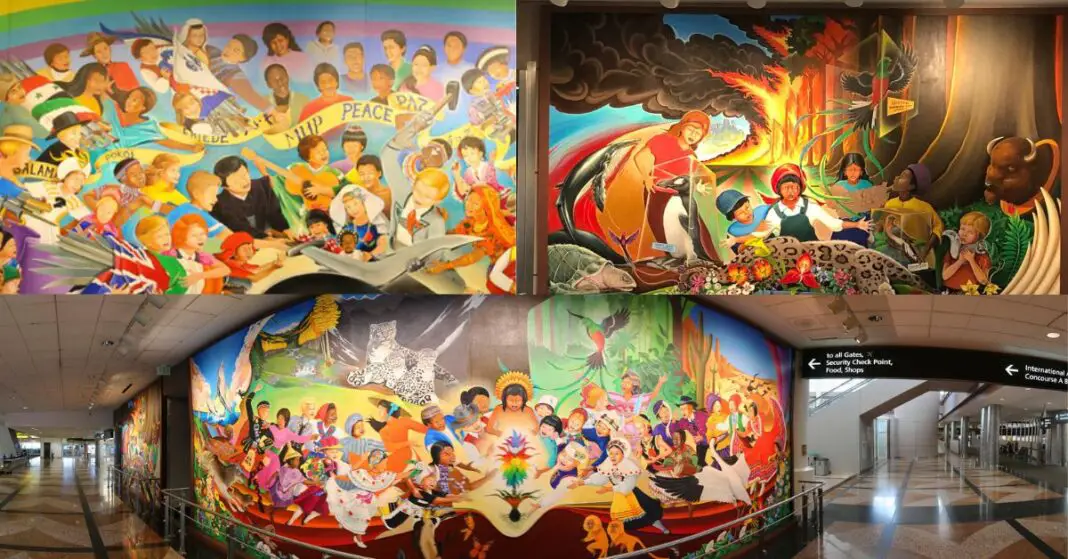Nestled within the vast expanse of Denver International Airport, an array of murals unfolds a canvas trailed with multilayered interpretations and theories. These murals, captivating in their aesthetics and intriguing residents and visitors alike, dive deep into potent themes such as peace, humanity, globalism, and the unsettling premise of environmental destruction.
While simultaneously sparking controversy, they ignite a healthy curiosity piquing into the politics of art and its potential to forewarn future calamities. The work of prominent artists like Leo Tanguma, steeped in rich history and skillful technique, lends a complex narrative to these iconic murals. Dotted with diverse symbols, each element within the murals tells a unique story, inviting a closer, more detailed inspection.
Table of Contents
Underlying Themes of the Denver Airport Murals
Denver International Airport, often renowned for its distinctive tent-like roof, also houses a rich collection of intriguing artwork that can leave passengers and art enthusiasts shaken up. Among these awe-inspiring art pieces are the controversial murals that often stir up conversations, theories, and speculations.
To even begin unearthing the deep-seated symbolism hidden within these murals, one must first become familiar with the recurring themes often depicted. Though wrapped in controversy, these themes can offer a valuable glimpse into the artist’s mindset, daringly touching upon global issues and human tendencies.
One of the most evident themes that strike visitors is “Peace and Harmony”. This theme is illustratively depicted in the mural, “In Peace and Harmony with Nature”. The expansive mural showcases children from varied backgrounds coming together, symbolizing unity and harmony. This recurring theme is a testament to an exploration of the concept of world peace and unification.
Another recurring theme is palpable in the murals is “War and Destruction”. Portions of some murals vividly depict images of war, violence, death, and devastation. In the mural called “Children of the World Dream of Peace”, a fierce military figure wearing a gas mask and wielding a sword that juxtaposes a fragile dove, portrays the devastation brought about by war.
These scenes of destruction evolve into a rebirth – a transformation – making the theme of “Humanity’s Rebirth & Healing” a prevalent one. This concept is primarily depicted in the mural, “The New World Airport Commission”, demonstrating people resurrecting the bird of peace from the ashes of war.
The murals also grapple with the anthropocentric theme, of “Human Impact on Nature”. Images of urbanization, deforestation, and animal extinction pervasively stringify this theme, which subtly hints at environmental concerns.
Finally, the allegorical idea of the “Apocalyptic” serves as a hauntingly recurring theme. Panels presenting a stark apocalyptic vision coupled with daunting imagery constitute this eerie theme. The aforementioned military figure, dead leopard, and apocalyptic setting altogether form a narrative of doom and catastrophe.
These recurring themes in the murals at Denver Airport act as the silent whispers of the artist’s daring perceptions, challenging the status quo and provoking contemplation. Taking the time to decipher these enigmatic art forms’ meanings and themes can lead to an enriching understanding of the bold and profound messages embedded within them, making a simple layover a journey of exploration and discovery. Now, you’re no longer merely passing through an airport, you’re touching upon history, culture, and thought-provoking artistry.
The artists behind the Denver Airport murals
Murals stand as visual narratives, echoing the voices of creative souls and rendering in vibrant colors the world’s tales. The hands that bring these murals to life belong to remarkable artists, each with their individualistic style, technique, and narrative to share. This spark of curiosity to know the maestros behind these massive canvases leads us on an explorative journey to appreciate not just the artwork but also its artists.
Among these muralists stands renowned artist Aleta Lee. Known for her murals portraying human resilience and spirit, Lee’s technique is intricate – realistic portraiture cloaked in abstract forms and hues. Her background in photojournalism and graphic design fuels her vision, turning each mural into a moving visual story. Her most distinctive work, “The Song of the Phoenix,” vividly portrays human resilience in the face of adversity.
Then there’s Elian Chali, an Argentinian muralist famous for his abstract portrayals of society’s impact on nature. Working exclusively with geometric patterns, Chali cements his style as modern and fresh while also carrying potent messages. His mural “Urbanization” encapsulates humanity’s dissonance with nature, using stark contrasts and complex geometrics.
An artist of German descent, Case Maclaim, marvelously combines conventional aerosol techniques with realism. His murals often depict a seamless dance between human figures and abstract forms—a testament to his theme of transformation. His most notable mural, “Embrace,” recounts destruction and rehabilitation, infusing hope into a post-apocalyptic world.
In contrast, French artist C215 (Christian Guémy), uses intricate stencil work to compose an engaging narrative. The hallmark of his style is humanity’s spirit portrayed through detailed portraits and the play of shadows. Often known as “France’s Answer to Banksy,” his murals focus on individuals amid chaos, as seen in “Sans Souci,” meaning without worries.
Lastly, South African artist Faith47 bases her murals on the theme of enduring rebirth and healing. By merging realist and spiritual aesthetics, she chronicles the mystical journey of mankind’s return from destruction. Her mural “Harmony Restored” stands as an emblem of peace rising through turmoil.
Indeed, an artist’s work tells the spectators more than a story—it portrays the artist’s spirit, their journey, the causes they uphold, and the messages they wish to convey.
Delving into their work history and techniques, it becomes evident that murals are not just large-scale art pieces, but they are the artist’s heart, painted open for the world to see. Each stroke, each color, and each shade is a testament to their artistic journey – Forever immortalized on the canvas of concrete.
Symbolism in the Denver Airport murals
As lovers of mural art, beyond the creativity and beauty of this art form, it is important to recognize the hidden layers, the underlying stories intertwined in the images artistically painted on the wall. Peeling back those aesthetic layers, we see an array of symbols and their potential meanings that stretch from personal experiences to societal commentary.
A crucial start is deciphering symbols relating to the Cycle of Life. Visual representations of birth, death, and re-birth are not uncommon. Drawing upon the universal themes of growth, decay, and difference, artists often employ the symbol of a tree – a universal symbol of growth and transformation in various cultures.
The cyclical process of trees losing leaves and growing them back can signify not only nature’s resilience but also the inevitability and acceptance of change, whether it reflects our own personal growth or societal transformations.
Treading further into the realm of symbols, we encounter implications of Power and Resistance. Fist symbols could be seen in murals worldwide, usually connoting defiance, rebellion, or overcoming adversity. Chains, on the flip side, can depict suppression, control, or struggle, but often, they’re also broken or rusted, symbolizing liberation, independence, and strength.
To move towards more ethereal symbols, we can often spot celestial bodies in murals. The use of moons, stars, and planets may hint at the cosmic play of human existence, or the insignificance of our problems compared to the vast expanse of the universe. However, these planetary symbols can also oversee the interconnectedness of all life forms, serenely emphasizing unity and wholeness in their silent, omnipresent, and all-accepting nature.
Mirroring the depths of the human soul, artists often incorporate symbols of duality. The yin-yang, day-night, or human-animal depictions dance around the themes of balance and unity. They display the coexistence of opposites, highlighting life’s paradoxes, the harmony in discord, and how contraries are vital for maintaining equilibrium.
The symbol of the Eye is another common aspect portrayed in mural art, often considered a ‘window to the soul.’ Whether the eyes are human, animal, or fantastical, they reflect deep introspection, wisdom, or surveillance, often perceived as a call for transparency and truth.
While the mural’s symbols are a direct reflection of the artist’s perspective, they also connect with the broader canvas of universal human experiences, feelings, and values. As admirers and interpreters of this expressive art form, it is indeed a rewarding endeavor to uncover these symbols and explore their meanings.
Grasping the artist’s unspoken language, we gain a deeper appreciation of the mural beyond its mere visual charm, forming a bond with the shared human story it unfolds. Remember, these symbols and their underlying messages resonate far beyond the painted wall. So, the next time you pass by a mural, pause, gaze, and plunge into the world of symbols waiting to be discovered.
Public perception and theories about the Denver Airport murals
The world of mural artistry provides limitless room for interpretation and analysis, making it a thriving hub for public opinion and theories. A common theme unearthed from public discourse is societal unity and disunity. This picks up where initial examinations of peace, war, rebirth, and human impact on nature cease.
Many believe murals adorned with depictions of unified bodies – hands held together, collective dancing, group huddles – represent a yearning for societal unity and togetherness. On the flip side, figures isolating them from groups, heads craned away from others, and visibly divided scenery implies societal disunity, a topic increasingly nuanced in modern times.
Next, people gravitate towards the theme of oppression and liberation. Fairly often, murals contain images of crying faces, bodies kneeling, or heads bowed in despair, believed to represent oppression.
Concurrently, other artworks present figures breaking off chains, faces turned upwards, and bodies in flight, symbolizing liberation from said oppression. This constant juxtaposition creates a powerful narrative of struggle, further complicated by the ambiguity of the oppressor.
As we venture deeper, concepts of time and eternity emerge from murals. Many artworks involve robust depictions of clocks, hourglasses, and sundials, all signifying time’s unyielding march. This prevailing theme often intertwines with depictions of death and rebirth, further feeding theories of cyclic existence and the preservation of legacy.
Moreover, murals often become the canvas for urban histories and cultural roots. Intricate historical tableaus, figures donned in traditional attire, and representations of indigenous wildlife indicate artists’ tributes to their cultural heritage. These pieces are believed to keep local histories alive in a rapidly globalizing world where identity and tradition risk alienation.
Lastly, the prevalence of natural elements is worthy of mention. Figurative portrayals of water, fire, earth, and air are found aplenty in murals across the board, among which, water exhibits the most versatility – can serve as a symbol of purification, rebirth or destruction depending on the context. Fire typically symbolizes transformation and change; Earth signifies groundedness and stability; Air, freedom, and liberation.
To the untrained viewer, these art pieces might seem like splashes of color and shape, perhaps even chaos. But as we unravel their layers and grapple with their symbols, murals morph from static visual narratives to dynamic conduits of deeper social, cultural, and philosophical dialogues. However, with interpretations subjective and ever-changing, it’s crucial to note that these theories are not fixed, forming a fluid testament to the depth and breadth of mural artistry.
Thus, these murals at Denver Airport are not merely pieces of artwork; they serve as intellectual puzzles seeping into the realms of the subconscious, sparking discussions, and inspiring individual interpretations. The wide array of public perceptions, ranging from admiration for their artistic merit to speculation about potential cryptic messages, reflects their impactful presence.
Whether perceived as visionary masterpieces or intriguing conundrums, the Denver Airport murals have undeniably woven themselves into the fabric of Denver’s cultural and artistic landscape, proving that artwork can transcend beyond aesthetic appeal and inspire dialogue and introspection.
So the next time you find yourself wandering through the sprawling corridors of Denver Airport, remember – each mural, each stroke is a tale beckoning to be unraveled.
What do the murals mean at the Denver airport?
The artworks at the Denver Airport, known as “Children of the World” and crafted by local artist Leo Tanguma, are intricate and can be understood in different ways. This has led to various speculations and conspiracy theories surrounding them.
Who painted the murals at DIA?
The murals at Denver International Airport were painted by artist Leo Tanguma. The most well-known ones are “Children of the World” and “Peace and Harmony” located in the Jeppesen Terminal.
Where are the creepy murals in Denver airport?
The murals at Denver International Airport, often referred to as unsettling, are named “Children of the World” and “Peace and Harmony with Nature.” These artworks were created by artist Leo Tanguma and can be found in the Jeppesen Terminal, positioned both to the east and west of the baggage claim area.
What is the controversial art at the Denver airport?
The murals by Leo Tanguma, particularly “Children of the World,” are the most contentious artworks at Denver International Airport. The stark contrast between images of war and peace in this mural has sparked controversy. Some viewers find the dark depictions of suffering unsettling. Additionally, interpretations of the gas mask figure in “In Peace and Harmony with Nature” vary, with some seeing it as a symbol of environmental despair.
Other controversial elements at the airport include the fiery “Blucifer” sculpture and enigmatic time capsules shrouded in mystery, contributing to speculative discussions. These artworks provoke debate due to their challenging themes, ambiguous symbolism, and their association with airport conspiracy theories.
Whether admired or condemned, these pieces undeniably contribute to the unique and provocative atmosphere at Denver International Airport.





